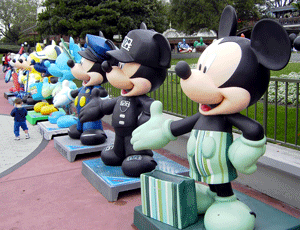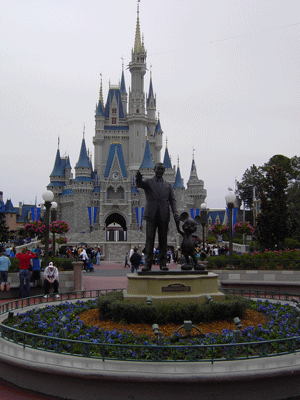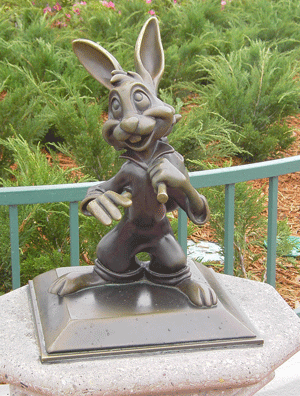
ESSAYS
A Rainy Saturday at Walt Disney World
By Michael Barrier
[Click here to read feedback about this essay.]
Writing about John Hench's book Designing Disney, as I did in a recent commentary, revived my interest in the Disney theme parks. In late January, when a business trip took me to Orlando, I seized the opportunity to pay my first visit to the Magic Kingdom theme park at Walt Disney World since 1974. (It had been fifteen years since I last visited Disneyland, its near-identical twin in California.) The day was cloudy, with light rain in the afternoon, and even though it was a Saturday, the crowds were small—at least by what I took to be normal standards. I shudder to think what the park is like when the huge parking lots are almost full, instead of almost empty.
With my forthcoming Disney biography in mind, I concentrated my attention on the rides and other attractions that are most "Walt"—that is, those that are clones of Disneyland attractions installed or planned when Walt Disney was still alive. (The Magic Kingdom didn't open until 1971, almost five years after Disney's death.) The Orlando park, like Disneyland itself, still bears Walt Disney's strong imprint, in its general organization and in many of the individual rides—remarkably so, considering that he has been dead almost forty years.
 As
I entered the Magic Kingdom, I was reminded immediately that animation
is at the heart of the Disney parks' success. I encountered seventy-five
statues of Mickey Mouse—each identical to start with but decorated
differently, in accordance with the wishes of some celebrity or
artist. The Mickeys are, in other words, an imitation of the famous
cows that briefly adorned the streets of New York and Chicago a
few years ago. The statues will tour the country later this year
in celebration of Mickey's seventy-fifth anniversary in 2003.
As
I entered the Magic Kingdom, I was reminded immediately that animation
is at the heart of the Disney parks' success. I encountered seventy-five
statues of Mickey Mouse—each identical to start with but decorated
differently, in accordance with the wishes of some celebrity or
artist. The Mickeys are, in other words, an imitation of the famous
cows that briefly adorned the streets of New York and Chicago a
few years ago. The statues will tour the country later this year
in celebration of Mickey's seventy-fifth anniversary in 2003.
Cartoon characters were inescapable throughout the park, not just in Fantasyland, where most of the rides piggyback on famous animated features, but in the other "lands," too. A bronze statue of Walt Disney decorates the plaza in front of Cinderella's castle, and he is depicted hand-in-hand with an off-model Mickey Mouse. That statue is surrounded by smaller bronzes of some of the more famous Disney characters, including the usual suspects: Donald, Minnie, Pluto, Goofy. There are only two characters from features, Dumbo and Brer Rabbit (see the illustrations below). The same Brer Rabbit, that is, whose only feature-film appearance is inaccessible to American audiences (except for those of us lucky enough to have acquired the Japanese laserdisc of Song of the South). I can't lay my hands easily on anything that tells me when those bronzes were erected, but Brer Rabbit would have been a curious choice even in 1971.
 Most
of the park's cartoon characters—present variously as costumed
performers or expensive merchandise or pretexts for rides—originated
in the Disney studio's own films. I was struck, though, by the number
of characters who originated elsewhere. The Disney affiliation of
one of the most important of those characters is under siege—the
company's rights to Winnie the Pooh are being challenged in court—and
it now appears that there will not be many new Pixar characters
in the park, either. Disney will retain the rights to the Toy
Story and Finding Nemo characters even if Steve
Jobs does follow through on his decision to end Pixar's Disney connection,
but what I saw in the Magic Kingdom tells me that Disney desperately
needs new Pixar characters in the pipeline. Given especially the
brutal, shortsighted cutbacks in Disney's feature animation division,
it's unlikely that new Disney characters can take up the slack left
by Pixar's departure.
Most
of the park's cartoon characters—present variously as costumed
performers or expensive merchandise or pretexts for rides—originated
in the Disney studio's own films. I was struck, though, by the number
of characters who originated elsewhere. The Disney affiliation of
one of the most important of those characters is under siege—the
company's rights to Winnie the Pooh are being challenged in court—and
it now appears that there will not be many new Pixar characters
in the park, either. Disney will retain the rights to the Toy
Story and Finding Nemo characters even if Steve
Jobs does follow through on his decision to end Pixar's Disney connection,
but what I saw in the Magic Kingdom tells me that Disney desperately
needs new Pixar characters in the pipeline. Given especially the
brutal, shortsighted cutbacks in Disney's feature animation division,
it's unlikely that new Disney characters can take up the slack left
by Pixar's departure.
I headed first for two venerable rides, "Pirates of the Caribbean" and "The Haunted Mansion," which I remembered as the most imaginative of the Magic Kingdom's attractions. I wondered if I would still feel that way after having last seen them (in their Disneyland incarnations) a decade and a half earlier. I came away having enjoyed both, but as I watched them I realized that these rides, filled with "Audio-Animatronic" robots, are, in effect, very large, very elaborate, and very strange displays of the kind that used to be found only in downtown department-store windows.
Pace John Hench, but not only is there no "story" in these displays, there's also not much to take its place—no substitute, that is, for the powerful narratives that have made the best Disney animated features so memorable. "Pirates" and "Mansion" are, rather, mechanical toys that echo Silly Symphonies of the mid-thirties—intricately clever, and delightful in their cleverness. The pleasures they offer are not to be despised, but they are unmistakably superficial compared with the pleasures to be found in, say, Dumbo.
There really is "story" in some Fantasyland rides, however, and I went on a couple of them, "Snow White's Scary Adventures" and "Peter Pan's Flight." I suppose that both rides have been spiffed up since they debuted decades ago, but they felt to me very much like the rides that bored me when I first visited Disneyland in 1969. Each offers a potted version of the film on which it's based, and I came away wondering how much someone who had not seen the films could enjoy the rides.

The department-store-window analogy suggested itself to me again
during the "Snow White" and "Peter Pan" rides.
Both rides are really a series of tableaux, and they would make
the most sense if spectators could linger over them, absorbing the
story from placards or recorded narration. I remember seeing just
such a retelling of a non-Disney version of "Sleeping Beauty"
in Saks Fifth Avenue's windows during the 2002 Christmas season
in New York. Needless to say, the long lines waiting for Walt Disney
World's rides make any such leisurely approach inconceivable.
Audio-Animatronic attractions are complex and challenging, but they—and
by extension theme parks themselves—are a dead end for anyone
whose ambitions are more than entrepreneurial. I think Walt Disney
accepted that reality toward the end of his life, when he began
turning away from the theme parks and devoting most of his attention
to EPCOT and CalArts and other heavyweight projects.
I skipped some of the other Audio-Animatronic attractions, like "It's a Small World" and the Hall of Presidents—my researcher's monomania extends only so far—but I did drop in to the revamped Enchanted Tiki Room. Two newer Disney birds, Iago from Aladdin and Zazu from The Lion King, have joined the parrots that have staffed this show for forty years. The Iago robot dominated the show, loudly and coarsely, robbing the Tiki Room of whatever campy charm it may once have had. His abrasive and very "Hollywoodish" manner may be a forecast of what lies ahead for the Disney parks; certainly the same reliance on bombast was evident in a raucous costumed-character show at Cinderella's castle.
Even though the Magic Kingdom still conforms to Walt Disney's wishes—"vision" is too grand a word—in its general layout and many of its details, the grating Tiki Room show reminded me of how different the Walt Disney Company is now from the much smaller operation that Walt ran.
Change needn't have been a bad thing. Walt Disney Productions was very much a one-man show when Walt Disney was alive, and when the one man can give only glancing attention to much of the work done in his name, his employees are likely to retreat into the safe and obvious. Certainly that tendency is visible in most of the films, animated and live-action, released under Walt Disney's name in the last decade of his life.
But what is most different now—what had few if any parallels in Walt's lifetime—is the coarseness, the noise, and above all the cynicism that infects so much of what is now called "Disney" and that occasionally flares up like an ugly boil, as in the Tiki Room. The general decay of American culture is to blame for some of this rot, but by no means all; Michael Eisner and his colleagues have been willing accomplices on too many occasions. If I have reservations about Roy Disney's campaign to displace Eisner (www.savedisney.com), that is only because I haven't seen in the projects that Roy has initiated himself (notably Fantasia 2000) sufficient traces of what made his uncle's best work so memorable.
In any case, Eisner is likely to survive as chief executive of the Walt Disney Company for a few more years. I will not be surprised if, by the end of his tenure, the Walt Disney Company's name has been changed to something more generic, a "Disney" to match "Ford" and other companies whose names no longer evoke the individuals who founded them. I will not be surprised, either, if in the years ahead the Magic Kingdom is less and less recognizable as Walt Disney's playground, his model-train layout grown to gargantuan size. I'm not sure what it will metamorphose into, but I suspect that the word "magic" will describe it even less accurately than it describes today's park.
[Posted February 4, 2004]